Аналоги халкона как потенциальные средства патогенетической терапии болезни Альцгеймера: in vitro-скрининг
- Авторы: Поздняков Д.И.1, Вихорь А.А.1, Руковицина В.М.1, Оганесян Э.Т.1, Плетень А.П.2, Прокопов А.А.2, Татаренко-Козмина Т.Ю.2
-
Учреждения:
- Пятигорский медико-фармацевтический институт – филиал ФГБОУ ВО ВолгГМУ
- Московский государственный медико-стоматологический университет имени А.И. Евдокимова МЗ РФ
- Выпуск: Том 27, № 2 (2024)
- Страницы: 43-47
- Раздел: Фармацевтическая химия
- URL: https://journals.eco-vector.com/1560-9596/article/view/627115
- DOI: https://doi.org/10.29296/25877313-2024-02-05
- ID: 627115
Цитировать
Полный текст
Аннотация
Введение. Болезнь Альцгеймера – одна из самых распространенных форм деменции, в основе патогенеза которой лежит накопление агрегатов β-амилоида в структурах головного мозга и развитие холинергического дефицита.
Цель исследования ‒ влияние аналогов халкона, на изменение активности ацетилхолинэстеразы и процесс агрегации
β-амилоида in vitro.
Материал и методы. В качестве анализируемых соединений выступали шесть бис-замещенных аналогов халкона, которые при проведении анализа растворяли в диметилсульфоксиде с получением двукратных разведений. Влияние изучаемых веществ на активность ацетилхолинэстеразы оценивали по модифицированному методу Эллмана. Изменение процесса агрегации частиц
β-амилоида определяли в реакции с конго красным после трех, шести и девяти дней инкубации. На основании полученных результатов зависимостей «% ингибирования‒концентрация» рассчитывали показатель IC50, который выражали в миллимолях на миллилитр.
Результаты. Показано, что анализируемые аналоги халкона подавляют процесс агрегации частиц β-амилоида, начиная с шестого дня инкубации с максимумом на девятый день. При этом соединениями, проявившими наиболее высокий уровень активности, являлись триметокси-замещенные вещества под шифрами AZBAX4 и AZBAX6, IC50 которых на девятый день исследования составил 21,4±0,928 ммоль/мл и 32,4±0,456 ммоль/мл соответственно. Для данных соединений установлен высокий уровень антихолинэстеразных свойств с IC50 35,9±0,991ммоль/мл и 25,1±0,261 ммоль/мл соответственно. Остальные исследуемые соединения демонстрировали меньший уровень активности.
Выводы. Проведенное исследование показало, что аналоги халкона под шифрами AZBAX4 и AZBAX6 подавляют активность ацетилхолинэстеразы и процесс агрегации β-амилоида in vitro, что делает данные соединения перспективными для дальнейшего изучения с целью разработки средств для патогенетического лечения болезни Альцгеймера.
Ключевые слова
Полный текст
Об авторах
Д. И. Поздняков
Пятигорский медико-фармацевтический институт – филиал ФГБОУ ВО ВолгГМУ
Автор, ответственный за переписку.
Email: pozdniackow.dmitry@yandex.ru
к.фарм.н., доцент, зав. кафедрой фармакологии с курсом клинической фармакологии
Россия, ПятигорскА. А. Вихорь
Пятигорский медико-фармацевтический институт – филиал ФГБОУ ВО ВолгГМУ
Email: nastyavihori@gmail.com
Студентка
Россия, ПятигорскВ. М. Руковицина
Пятигорский медико-фармацевтический институт – филиал ФГБОУ ВО ВолгГМУ
Email: rukovitcinavika@mail.ru
к.фарм.н., ст. преподаватель, кафедра органической химии
Россия, ПятигорскЭ. Т. Оганесян
Пятигорский медико-фармацевтический институт – филиал ФГБОУ ВО ВолгГМУ
Email: pozdniackow.dmitry@yandex.ru
д.фарм.н., профессор, зав. кафедрой органической химии
Россия, ПятигорскА. П. Плетень
Московский государственный медико-стоматологический университет имени А.И. Евдокимова МЗ РФ
Email: pozdniackow.dmitry@yandex.ru
д.б.н., профессор кафедры биологической химии
Россия, МоскваА. А. Прокопов
Московский государственный медико-стоматологический университет имени А.И. Евдокимова МЗ РФ
Email: pozdniackow.dmitry@yandex.ru
д.х.н., доцент, зав. кафедрой общей и биоорганической химии
Россия, МоскваТ. Ю. Татаренко-Козмина
Московский государственный медико-стоматологический университет имени А.И. Евдокимова МЗ РФ
Email: pozdniackow.dmitry@yandex.ru
д.б.н., профессор, зав. кафедрой медицинской биологии c основами клеточной и молекулярной биотехнологии, НОИ «Клиническая медицина им. Н.А. Семашко»
Россия, МоскваСписок литературы
- Khan S., Barve K.H., Kumar M.S. Recent Advancements in Pathogenesis, Diagnostics and Treatment of Alzheimer's Disease. Curr Neuropharmacol. 2020; 18(11): 1106‒1125. doi: 10.2174/1570159X18666200528142429.
- Barage S.H., Sonawane K.D. Amyloid cascade hypothesis: Pathogenesis and therapeutic strategies in Alzheimer's disease. Neuropeptides. 2015; 52: 1‒18. doi: 10.1016/j.npep.2015.06.008.
- Brum W.S., de Bastiani M.A., Bieger A., et al. A three-range approach enhances the prognostic utility of CSF biomarkers in Alzheimer's disease. Alzheimers Dement (N Y). 2022; 8(1): e12270. Pub-lished 2022 Mar 13. doi: 10.1002/trc2.12270.
- Hampel H., Mesulam M.M., Cuello A.C., et al. The cholinergic system in the pathophysiology and treatment of Alzheimer's disease. Brain. 2018; 141(7): 1917‒1933. doi: 10.1093/brain/awy132.
- Podtelezhnikov A.A., Tanis K.Q., Nebozhyn M., et al. Molecular insights into the pathogenesis of Alzheimer's disease and its relationship to normal aging. PLoS One. 2011; 6(12): e29610. doi: 10.1371/journal.pone.0029610.
- Ferreira-Vieira T.H., Guimaraes IM, Silva F.R., Ribeiro F.M. Alzheimer's disease: Targeting the Cholinergic System. Curr Neuropharmacol. 2016; 14(1): 101‒115. doi: 10.2174/1570159x13666150716165726.
- Yu T.W., Lane H.Y., Lin C.H. Novel Therapeutic Approaches for Alzheimer's Disease: An Updated Review. Int J Mol Sci. 2021 Jul 30; 22(15): 8208. doi: 10.3390/ijms22158208. PMID: 34360973; PMCID: PMC8348485.
- Wang W., Zhao C., Zhu D., Gong G., Du W. Inhibition of amyloid peptide fibril formation by gold-sulfur complexes. J InorgBiochem. 2017; 171: 1‒9. doi: 10.1016/j.jinorgbio.2017.02.021.
- Durmaz Ş., Evren A.E., Sağlık B.N., et al. Synthesis, anticholinesterase activity, molecular docking, and molecular dynamic simulation studies of 1,3,4-oxadiazole derivatives. Arch Pharm (Weinheim). 2022; 355(11): e2200294. doi: 10.1002/ardp.202200294.
- Thapa A., Jett S.D., Chi E.Y. Curcumin Attenuates Amyloid-β Aggregate Toxicity and Modulates Amyloid-β Aggregation Pathway. ACS Chem Neurosci. 2016; 7(1): 56‒68. doi: 10.1021/acschemneuro.5b00214.
- Tello-Franco V., Lozada-García M.C., Soriano-García M. Experimental and computational studies on the inhibition of acetylcholinesterase by curcumin and some of its derivatives. Curr Comput Aided Drug Des. 2013; 9(2): 289‒298. doi: 10.2174/15734099113099990007.
Дополнительные файлы






